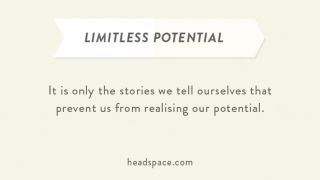It is often said that as human beings we’ve got limitless potential. But how can we practically apply this to our experience of meditation? How can we use this idea to motivate us in our daily practice? Let Meditation experts Headspace take you the through 5 steps to help you recognize your innate boundless creativity and resourcefulness in your practice and beyond.
Step 1 Limitless Potential
Everything is possible. In the same way that scientists can find no end to time and space, the same can be said of the mind. Where does it begin and where does it end? And if there are no limits, then what, or who, is holding us back? If everything is possible, then what, or who, is preventing change taking place? It is only the stories we tell ourselves that prevent us from realising our potential, and it is only our fear in letting go of these stories that prevents us from experiencing the true nature of the mind.

Limitless Potential
Step 2 Shared Experience
When we sit to meditate on our own, it can be tempting to think we’re alone. But being alone and being on our own are two very different things. The human condition, both body and mind, is something we share. Nowhere is this experienced more intimately than in the spotlight of awareness cultivated in meditation. There will be times when we are acutely aware of this connection and, somewhat inevitably, times when we close ourselves down. But either way, we are never alone when we sit and observe thoughts with an open mind.
Step 3 Overcoming Obstacles
Obstacles are at the heart of learning something new. In fact in many ways we could even say they are the process of learning itself - the only alternative being that we have already perfected that ‘something new’ and therefore have nothing left to learn. It’s so easy to forget this simple fact and to get frustrated or impatient when an obstacle arises in our meditation. But this arising of obstacles is in itself the process of learning. This is what it means to train the mind, to cultivate the art of awareness and compassion. This is what it means to meditate.

Overcoming Obstacles
Step 4 For the Benefit of All
Although we may sit alone to meditate, the benefit is infinite. When we’re unhappy, confused or out-of-sorts, it has a very real effect on the people around us. How could it not? So it only makes sense that when we feel happy, calm and clear in our life, that those same people should benefit. Needless to say, we can’t be responsible for the happiness of others (that’s down to them), but we can most definitely help provide the conditions for them to experience happiness. And who’s to say where it goes from there...like a ripple, expanding outward, without end.
Step 5 Dedicated Focus
To become good at something, really good at something, requires many things. But most of all it requires dedication. It requires us to show up, to engage and participate in the experience. Without this, everything else is just theory, ideas and projection. There is no good or bad meditation, there is only distraction or non-distraction, awareness or non-awareness. All we need to do is to turn up each day, to sit, to gently follow the breath as we observe the activity of the mind with a kind and gentle focus. To do this, is enough.
.

Dedicated Focus
Want more tips on how to make meditation a part of your day? Headspace is meditation made simple, accessible and relevant to your everyday life. Sign up for free to our Take10 programme to get the basics just right with guided audio programmes and support and get your Headspace, anytime, anywhere on the Headspace app. And if you find that you're feeling the benefits of some Headspace then why not take advantage of our fantastic Psychology Today reader offer


